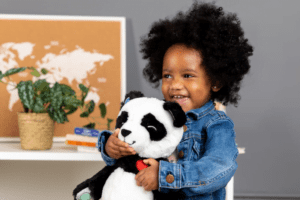Teaching kindness and compassion in children can set them up for a lifetime of healthy self-esteem, satisfying relationships, and increased happiness. These skills are essential in their overall development- as social beings, we all need to learn how to share, listen, and be empathic to others.
Why Is It Important for Children to Learn Kindness and Compassion?
We all know how good it feels when someone is nice to us. Teaching kindness and compassion helps children feel more productive and empowered in their lives.
Moreover, it can:
- Create a greater sense of belonging among their peers.
- Reduce bullying and exclusion at school.
- Enhance feelings of gratitude.
- Strengthen resilience.
- Decrease symptoms of depression or anxiety.
How Can I Help My Child Learn to Be Kind and Compassionate to Themselves?
Kindness starts with ourselves. When we can practice internal patience, tolerance, and forgiveness, we naturally tend to share these same traits with others. Here are some simple ways to promote this skill for your children.
Model Self-Compassion
Your children will internalize and mimic how they see you behave. If you are critical towards yourself, they learn that self-loathing is normal and even acceptable.
Be mindful of how you talk to yourself. Avoid making negative comments about your appearance or behavior. Instead, try to be honest without shaming. For example, you might say, I made a mistake and picked you up late today. We’re all forgetful sometimes. I’m sorry!”
Embrace Positive Affirmations
It can be helpful to teach your child positive statements they can tell themselves when they feel discouraged or overwhelmed. Some good examples include:
- “I am good enough.”
- “I am doing the best job I can.”
- “No matter what happens, people love me.”
- “I am a great person.”
- “I can always learn from my mistakes.”
Accept All Feelings
Even from a young age, children must be taught that their feelings are entirely valid. They need to recognize that it’s okay to feel emotions like sadness, anger, fear, or guilt. When they can accept how they feel, they won’t feel as burdened.
As a parent, it’s important that you have ongoing conversations about identifying and accepting feelings. Be mindful of the tendency to dismiss or criticize your child’s experience. After all, just because you don’t think something is scary doesn’t mean your truth is the only reality!
Make it a point to label and validate feelings as you recognize them. For example, if your child refuses to do their homework, you might say, “I bet you’re feeling tired and annoyed right now. You don’t want to do this homework. It might be overwhelming. I totally get that, but I do need you to get started on it.”
Always Validate Their Worth
It’s essential that you help children recognize that they are worthy despite any external factors. This is the basis of unconditional love.
You can certainly discuss and set boundaries around problematic behaviors. But it becomes shaming if you tie a behavior with someone’s sense of self. For example, if you observe your child hitting her brother, avoid saying, “you’re being so mean!”
Instead, you can frame it as, “Hitting is a mean behavior, and I don’t want you to hurt him. Please stop.” This statement focuses on the specific behavior, not the child’s personality or identity.
How Can I Help My Child Learn to Be Kind and Compassionate to Others?
Kindness and compassion emerge from repeated practice. The more your children can learn and practice these skills, the more likely they will use them in the real world. Here are some considerations.
Assume Your Child is Capable
Always give your child the benefit of the doubt. Even if you struggle with some of their behavior, it isn’t helpful to believe they can’t be kind towards others. If you always assume they’re a troublemaker, they will internalize that belief and likely reinforce it every chance they can.
Make it a point to emphasize any positive efforts you notice. For example, you might say, I saw how you let that little girl take a turn on the slide before you. That was so kind of you!”
Create Moments for Empathy
When you’re out with your child, make an effort to point out how other people might be experiencing a particular situation. For example, your child might observe another child crying at the grocery store. You might ask, “How do you think that little boy is feeling right now?”
If your child isn’t sure, you can offer your suggestion. You could say, “I think he looks sad. Maybe he’s upset that his mommy isn’t buying him ice cream. That can be frustrating.”
Discuss Kindness as You Observe It
Children absorb everything around them. They constantly scan their environment for cues about how they should think and behave.
You can take advantage of their natural curiosity by narrating kind and compassionate moments. If you’re reading a book together, you could highlight how kind it is that one of the characters is sharing her lunch with her friend. Or, if you a cashier is being particularly friendly, you might note how good it feels when someone is nice to you.
Encourage Giving Back
Even at a young age, children can reap the benefits associated with volunteering. Helping others makes the world a better place, and it also feels good.
With smaller kids, ask them if they can part with any toys or books to give to other children. You can also encourage charitable acts, such as picking up litter, recycling, and conserving water. Older kids may enjoy more hands-on experiences, like volunteering in a shelter or nursing home.
How can Pause with Panda help teach Kindness and Compassion?
Pause with Panda’s “Love” button features short mindfulness exercises called “Pauses” designed for children to practice sending themselves and others love and kindness. Children might listen to “My Friend, Me” to work on developing self-compassion or “Send Kind Wishes” to foster empathy for others.
Pause with Panda also makes affirmations easy and fun by letting children or adults record their own affirmations to listen to via Panda’s Smart Heart button (will add hyperlink to learn more about Smart Heart button).
Final Thoughts
Kindness and compassion ultimately start in the home. Therefore, as a parent, it’s crucial for you to model how you value these traits in yourself and in others.
Make it a priority to emphasize how you expect your children to treat others. Praise positive behavior and offer constructive feedback for less-desirable negative behavior. But, most of all, make sure that you practice what you preach!



